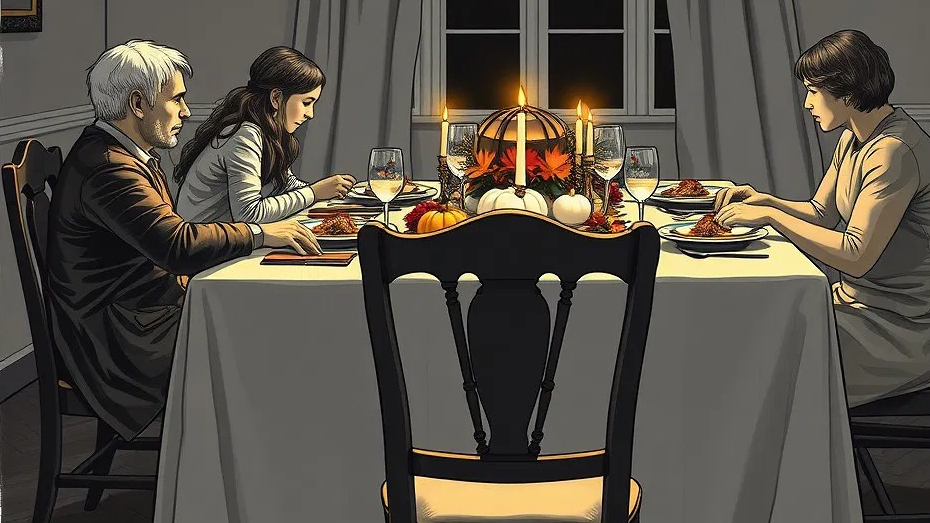Find a Trusted Proivder
Helpful Links

Business Hours
- Mon - Fri
- -
- Sat - Sun
- Closed

Share This Article
Often, grief comes in waves and can hit unexpectedly rather than flow in orderly stages.
Grief is one of the most personal and profound experiences a person can go through. Yet despite its depth, it’s often simplified in popular culture as a series of “stages” we’re expected to progress through, as if we’re climbing rungs on a ladder toward “moving on.” The five stages of grief—denial, anger, bargaining, depression, and acceptance—have become widely known, and many people assume that grief follows this predictable path.
The reality, however, is much more complex. In fact, the concept of “stages” can actually misrepresent what grieving is like, leading to misunderstandings and even feelings of inadequacy when people don’t fit into these so-called stages. In this article, we’ll explore why grief doesn’t fit neatly into stages, and what understanding grief really looks like.
Origin of the 5 Stages: How a Simple Model Became a Grief “Roadmap”
The five stages of grief come from the work of psychiatrist Dr. Elisabeth Kübler-Ross, who introduced the model in her 1969 book On Death and Dying. It’s important to note that Kübler-Ross developed this model based on interviews with terminally ill patients, describing the stages they went through after receiving a terminal diagnosis—not after the death of a loved one.
Over time, however, the model was adapted to describe the experiences of people grieving the loss of a loved one, not just those facing their own mortality. Although the stages were originally intended to explain one specific kind of grief, they became broadly accepted as a general guide to all grief experiences.
This expansion was well-intentioned but ultimately limited in its view of grief, failing to capture the complexity, individuality, and non-linear nature of loss. Let's try to debunk some of the popular myths that have since been associated with these five stages.
Myth 1: Grief Follows a Linear Path
Reality: Grief isn’t a series of steps to “get through” but rather an unpredictable, individual experience.
One of the biggest misconceptions about the five stages is that they happen in a predictable order. According to the model, people go through denial, then anger, followed by bargaining, depression, and finally reach acceptance. This structure can make it seem like grief is a process with a clear beginning and end.
In reality, grief doesn’t follow a specific path. People can experience anger without denial, or they may feel moments of acceptance followed by periods of sadness. In some cases,
emotions like guilt, relief, or yearning
might be the most intense, even if they don’t fit into the classic stages.
Psychologist Dr. George Bonanno, author of
The Other Side of Sadness, explains, “Grief is not a predictable process but a flexible and dynamic experience that varies greatly between individuals.” For some, grief can feel cyclical, with waves of different emotions resurfacing over time.
Myth 2: You Have to Go Through Each Stage to Move Forward
Reality: Grief doesn’t have prerequisites, and there’s no need to “complete” certain emotions.
Another common belief is that each stage represents a necessary milestone, meaning you must experience all five before you can “heal.” People may worry if they don’t feel anger or bargaining, or they might feel pressure to move toward acceptance.
Grief doesn’t work this way. You don’t need to experience anger to eventually feel peace, and you don’t have to go through bargaining to reach a place of acceptance. The idea that you have to experience all the “stages” can create feelings of inadequacy, especially if certain emotions don’t resonate with you. The truth is that each person grieves differently, and there’s no
checklist to complete.
As grief expert Dr. Alan Wolfelt says, “There’s no ‘right’ way to grieve. People experience grief in their own way and in their own time.”
Myth 3: Acceptance Means You’re Done Grieving
Reality: Acceptance isn’t an “end point” to grief, and it doesn’t mean you stop feeling the loss.
Many people assume that “acceptance” means reaching the end of grief, as if it’s the final box to check before you can “move on.” However, acceptance doesn’t mean that you’ll no longer miss or feel sadness about the person you’ve lost. Acceptance is often more about
learning to live with the reality of the loss, rather than “getting over” it.
Acceptance, if it comes, doesn’t mean that all sadness or longing disappears. You might feel moments of acceptance early on, and then revisit deep grief later. Rather than an end point, acceptance is often an ongoing process of adapting to life without your loved one while still carrying them in your heart.
“Grief is not something that you complete, but rather, it’s something you endure. It doesn’t go away; it simply changes shape over time,” writes author Megan Devine in her book It’s OK That You’re Not OK.
Myth 4: The Stages Cover All Grief Reactions
Reality: Grief includes many emotions not captured in the five stages.
While the five stages are limited to denial, anger, bargaining, depression, and acceptance, grief often includes many other feelings. Relief, guilt, yearning, confusion, and even moments of joy or laughter are common responses after a loss. Each person’s experience is shaped by their relationship with the person they lost, their personality, and their life circumstances, meaning that no model can capture it fully.
For example, someone who cared for a loved one through a long illness might feel relief mixed with sadness after their passing. Someone else may feel intense yearning or a need to talk about their loved one every day. These feelings are not wrong—they’re simply part of the natural range of human responses to loss.
Grief counselor David Kessler, who worked closely with Kübler-Ross, emphasizes, “The stages were never meant to limit or define all possible emotions. They’re just one perspective among many ways people experience loss.”
Myth 5: The Stages Help Make Grief Predictable
Reality: Grief is inherently unpredictable, and that’s okay.
One of the appeals of the five stages model is that it promises a sense of predictability, a way to understand what lies ahead. However, grief is deeply personal, and its unpredictability can feel unsettling, especially in a culture that values control and resolution.
The truth is that grief changes over time, sometimes in unexpected ways. There may be quiet days, when the pain feels manageable, followed by a sudden wave of sadness triggered by a memory or anniversary. This lack of predictability doesn’t mean something is wrong. It simply reflects the ongoing relationship we have with those we’ve lost—a relationship that continues to change and grow even after they’re gone.
As Dr. Robert Neimeyer, a psychologist who specializes in grief, puts it, “Grief often defies easy categorization. It’s more about learning to integrate the loss into your life than progressing through fixed steps.”
Moving Beyond the Stages: A Personalized Approach to Grief
If the five stages of grief don’t fully capture the grieving process, then how can people understand and approach their own grief? One helpful perspective is to view grief as a journey rather than a destination. Grieving is about learning to live with the loss, finding new ways to connect with the memory of a loved one, and honoring your unique experience.
Here are some ways to support yourself or others through grief without relying on stages:
Acknowledge your unique experience: Each person grieves differently. Your reactions and timeline will be influenced by your relationship with the person, your personality, and your life experiences. Allow yourself to feel whatever comes up, even if it doesn’t fit into any “stage.”
Seek support that validates your feelings: Whether it’s a friend, family member, or grief counselor, talking with someone who listens without judgment can help you process your emotions. Support groups and grief resources can also provide a sense of community and remind you that you’re not alone.
Create rituals and remembrances: For many people, creating rituals—such as lighting a candle, visiting a meaningful place, or starting a memory journal—helps them honor their loved one and process their grief over time.
Allow for unpredictable emotions: Grief often involves cycling through different feelings. Embrace this unpredictability as part of your journey, without feeling pressure to reach a certain emotional state.
Trust the process: Grieving is an ongoing experience, and there’s no need to rush it. Trust that with time, the sharpness of the pain will soften, and you’ll find new ways to carry forward your loved one’s memory.
While the five stages of grief are widely known, they represent only one view of what grieving looks like. Grief isn’t a tidy, step-by-step process but rather a unique, unpredictable journey shaped by our relationship with those we’ve lost. Moving beyond the stages allows us to honor our own experience, whether it involves moments of sadness, joy, confusion, or healing.
In Conclusion
There’s no “wrong” way to grieve. I know this sounds cliche but in all honesty, your experience is naturally unique to you and you have all the rights to react to and maneuver through it how you want. The best approach is one that respects your individual needs, values, and emotions, providing space for all the complexities that come with love and loss.
Are you grappling with grief and feeling overwhelmed? Talking to a
qualified grief counselor can be helpful to some extent and we encourage you to
find help near you today.
Related Articles
Related Articles





